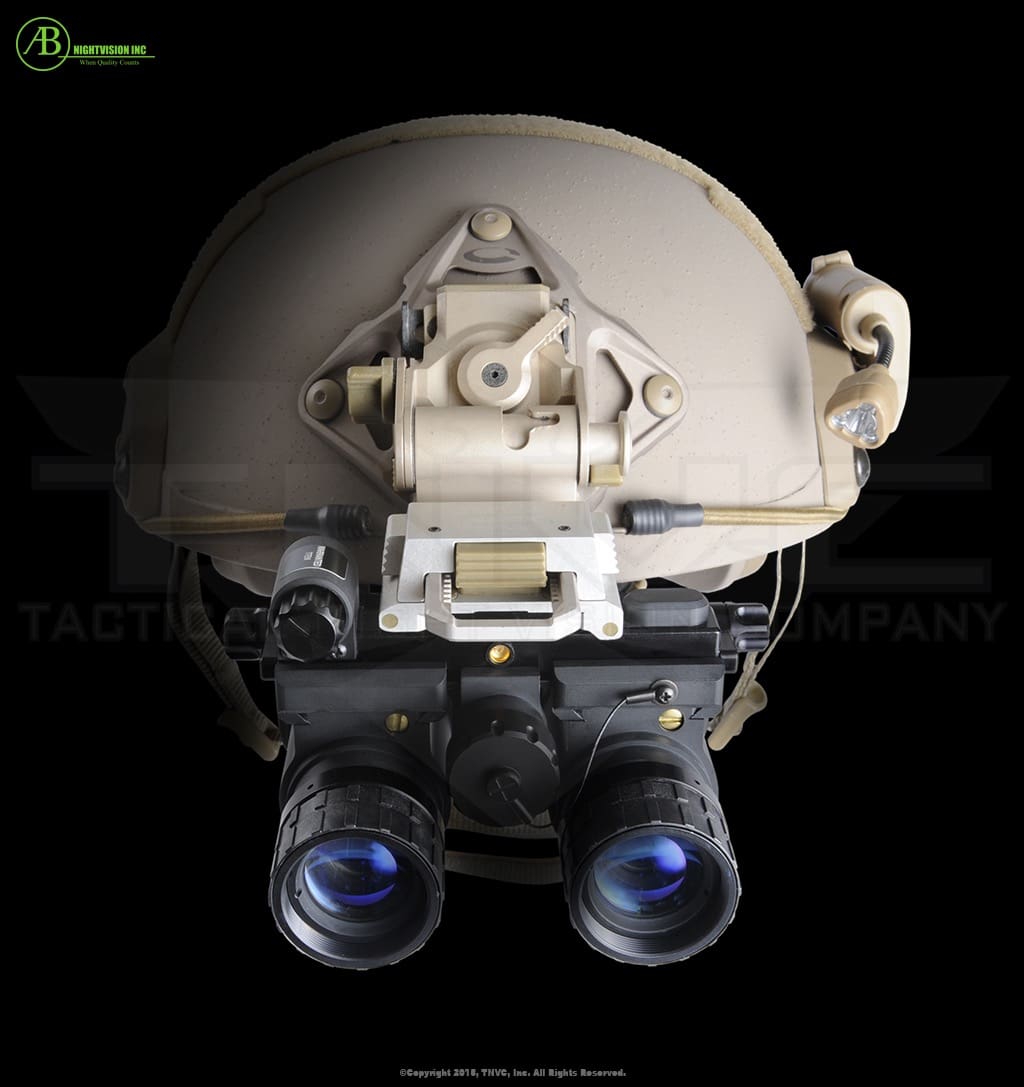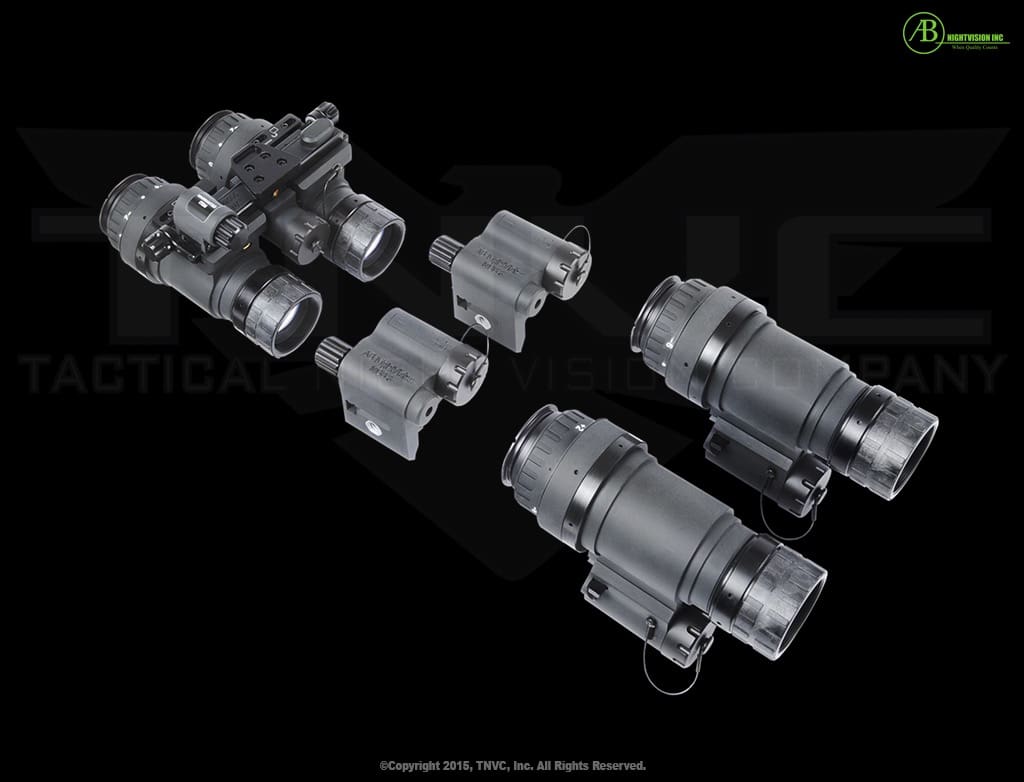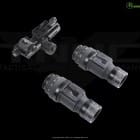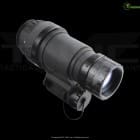TNVC is now offering the incredible MOD3 Night Vision Goggle System. The MOD3 is the most modular goggle ever created and features a fully functional binocular system that can be broken down into two individually-operating monoculars in seconds. TNVC assembles the MOD3 with brand new high spec L-3 OMNI VIII MX10160 image tubes complete with factory data sheets.
Until now you could either have a binocular or monocular. The MOD-3 overcomes this problem by utilizing Optical Pods that are waterproof, Nitrogen purged units that can be installed into either a monocular or binocular. Power is conducted to the intensifier tube and indicator LEDs by means of spring loaded, gold plated contacts. Even the springs are gold plated to prevent corrosion.
The Optical Pods can be assembled in the MOD-3 Binocular Bridge to form a full function binocular. A latching mechanism firmly holds the Optical Pods in place and is easily manipulated with one finger. Installing or removing the Optical Pods is accomplished in just a couple seconds.
The other half of the MOD-3 system is the MOD-3 Monocular Adapter. This adapts an Optical Pod into a full function monocular. It has the same circuitry as the Binocular Bridge which means you have a flood IR LED, IR “on” indicator, and low battery indicator. It uses the 3V lithium battery as well. It also accepts the IR Spot/Flood adapters like the PVS-7 goggles use.
Like the Binocular Bridge, the Monocular Adapter releases the Optical pod with the press of one finger, allowing instant changeover from monocular to binocular. The monocular housing is waterproof and has a side mount like a PVS-14, allowing you to use it as you would any other monocular with head and weapon mounts. The monocular is 75 grams lighter than a PVS-14.
All MOD3 kits come complete with two full assembled Optic Pods with MILSPEC PVS-14 Objective and Eye Piece Lenses, One Binocular Bridge, and two Monocular Adapters. The Binocular bridge will attach to any dovetail night vision mount interface while the monocular adapters simply require the addition of any PVS-14 J-Arm to attach to a helmet mount.
tnvc.com/shop/ab-nightvision-mod3-modular-goggle-l-3-omni-viii/
Tags: TNVC







Slick.
It’s good to see the EO business take the path of modularity. Holsters are modular (or at least non-specific), rifles are mix-modular, suppressor too, and our aircraft are even common major components-why did it take so long?
As with all good ideas there are alway the reasonings and trade-off’s which have to understood by the users/purchasers, particularly high cost items in which the few understand to a point beyond enthusiast levels.
EO is one of those items-that “once you go electro, you kick and fight not to go back to white light only”. Who can serve in any branch of service and not leave and want the wares of the job? Particularly when essentially everything can be had that you were issued if you have the resources-and the cash. Essentially everything. Biting the bullet for $8K-10k is well, rough. And goggles, they cost.
There are probably no less than a dozen of the top experts on nearly any industry subject and discipline visiting or contributing on this website. Scrutiny is ever present. Not so much with EO very regularly by comparison. it’s a little different animal optics are.
Modularity is good.
Weight on the head is not.
Capability is good, as is redundancy.
The device here is a huge step ahead in refining the attributes of existing and known use component to enhance the users wants and enthusiasts requests.
The part that needs some refinement is the use of the word-goggle. That word is, in the eyes of many abused. This device by typical definition is not a goggle by definition. This is important for everyone to understand as a common foundation or benchmark.
The device pictured uses PVS-14 style (it appears) optics on both the objective and eyepiece ends. Both of these eyepieces rotate both the mechanical elements as well as the optical stack in those mechanicals. This means they spin as a whole, like a wheel without center bearings (loose reference). This is an efficient and cost effective optic. Hence its place on a monocular device of wide issues/use.
A device such as the PVS-15 has a very different (and expensive) design. (removing tubes from the equation completely). The reason-optics. The PVS-15 has some of the best optics desiged. These optics are telescoping lenses that slide in/out of the rotating mechanicals. Only the focus ring rotates as both the front/rear lenses move towards or away from the tube without turning those lenses. That’s item number one.
Item two, convergence. Since the PVS-15 optics are essentially centered on the tube and do not rotate they are now fixed, similar to centering a rifle barrel on a precision action (again, loose comparison). If you ever used a UNS clip-on sight then you used a collimated optic like on the 15’s-just without bore sight (yet). And just as the factory bore sights a sight, the 2 concentric optical paths have to be focused to a certain point-convergence, just like your eyes converge when you look at anything closer than about 25 meters or so. Just like the eye doctor tests you with that pencil to ensure your eyes are converging as you focus on closer items.
Rotating optics are nearly impossible to center if they rotate. That’s why that day sight lens also moves in/out. If they can’t be centered the. They can’t be controlled to a convergence point, a set distance prescribed by various defense entities.
What about those super fancy PVS-31’s and PNVG’s? Some of those optics rotate, don’t they? Yes, some of this are different. But in almost every case the optical design is so high end and the tolerances so tight that only one end rotates minimally and the other lens (eyepiece) is static. Any dioptic correction is made with snap-in correcting elements. These lenses can cost 3-5X themselves and cost equal to the tube in many examples.
This is not a rejection of the device here, as this is a novel design and much work was obviously done to enrich the capabities of and provide capabities to the many folks akin to dual tube systems. Some clarity should be provided as to strict definitions to respect the benchmarks of historic devices, and those going forward.
Also, tubes are usually matched in a goggle in various ways to limit differences the eyes note when stereoscopic vision/depth perception is the objective. Change tint in one of your sunglasses lenses and note the change.
Wonderful points. +1
I think the PVS-31 and GPNVG lenses are the wave of the future. Eventually they will get cheaper and be more accessible, possibly even backwards compatible. The PVS-14 optics are quite old and simplistic. The ANVIS optics are even older than that.
I have never even seen PVS-15/18 optics on the gray market, although maybe I have not looked quite as close as I should.
Exactly. ‘Goggle’ is a term used loosely to describe a bridge connecting two PVS-14-like monoculars together (a concept that has been done before by multiple companies in the NV industry). However, you are incorrect about matching the tubes. A stereoscopic image actually reduces the need for a cleaner tube in either side, as the brain ‘fills the gaps’ by compensating the image seen in one eye with the image seen in the other. You are correct about the collimation of the two images though. The PVS-15, PVS-31, GPNVG, all have collimated tubes; meaning, the optics have been pointed in the right direction with a digital machine. By manually combining two PVS-14s to a bridge, I doubt there is any form of collimation, or repeatability if there is, resulting in a crosseyed like effect when using the goggle for extended periods of time.
Pretty sure nightlongindustries did this first.
I don’t think thats all too accurate…
Wilcox came out with a bridge for the MUM-14 four years ago.
Mod Armory came out with a bridge for the PVS-14 two years ago (shortly followed by another PVS-14 bridge from Wilcox).